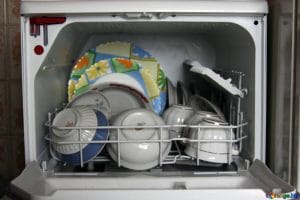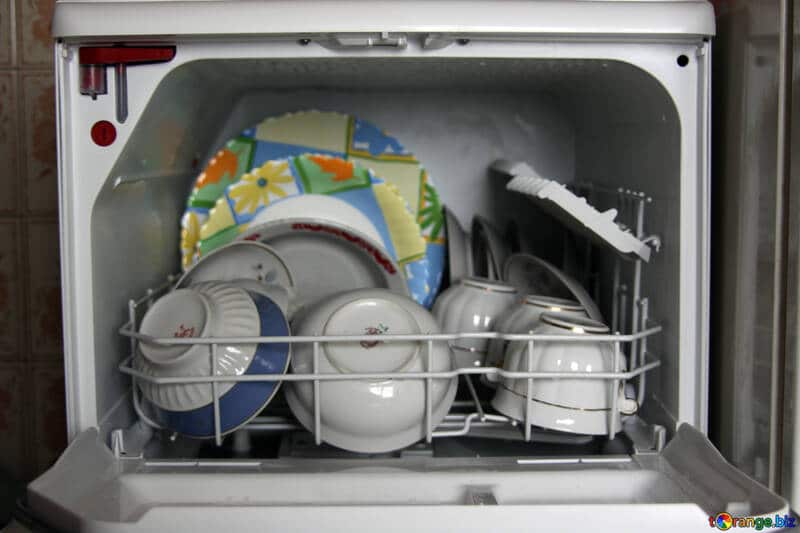The most frequent reasons why your dishwasher is not drying the dishes well are:
- not selecting the right washing option (some washing cycles don’t include drying)
- not selecting the heat setting (if your dishwasher has this on the panel)
- a malfunctioning heating element or heating assembly
- a malfunctioning high limit thermostat
- rinse aid dispenser not working or not enough rinse aid
- vent or vent fan not working (if your dishwasher has one)

It’s important to understand how your dishwasher dries the dishes before searching for solutions. Depending on your dishwasher’s model, your machine can use one or a mix of the following mechanisms to dry the dishes:
- heated air
- heated rinse
- fan
- air dry
Heated air
Heated air is used on older models, but not on new models because it’s not energy efficient. This method uses hot air to dry the dishes.
Heated rinse
Heated rinse is used on newer models and it’s using the condensation principle. As the name suggests, the final rinse is done with very hot water. The metallic case of the dishwasher is a good heat conductor and attracts moisture from the dishes. This way, the water evaporates quickly leaving the dishes dry.
Using a fan
The fan method is energy efficient and used on new models. It circulates air inside the dishwasher. The air helps to evaporate water from the dishes. The main advantage is that the air doesn’t need to be hot.
Air drying
Air drying is very simple and used on the newest models of dishwashers. It automatically opens the door when the washing cycle is over. Optionally, it does a hot rinse just before. The water and moisture evaporate quickly because all the humidity will escape the dishwasher case.
The dishes will be dry in 10-30 minutes depending on your dishwasher model and if it does the hot rinse before the end of the cycle.
Find out which of the systems your dishwasher is using by consulting your user’s manual or searching for your specific model specs online.
How to fix your dishwasher not drying properly
How that you’ve identified how your dishwasher machine dries dishes you can proceed to the troubleshooting stage.
Fixing the heating element
The heating element heats the water during the rinse and wash cycles. Depending on the system that your dishwasher uses to dry dishes it may also heat the air within the heated dry cycle. You may notice that this part is malfunctioning if the dishwasher’s case is not getting hot during the wash on a regular program (not eco, as that program is using only moderately heated water).
The heating element is located at the bottom of the dishwasher. In order to access it, you will need to take the bottom panel off.
Then, you will need to test the heating element to see if it’s really dead. Visual inspection may be enough. If the heating element is damaged or ruptured it is clear that it will need replacing.
But sometimes you will need to perform a continuity test in order to make sure the heating element is damaged. You can do this with a normal multimeter. If the electrical path is broken at some point the heating element won’t work.
Steps:
- Get a multimeter
- Set it to resistance (ohms, symbol: Ω) or resistance with tone (looks like a wi-fi symbol and it’s next to the normal resistance setting)
- Select the lowest setting, usually 200 ohms or something like that depending on your multimeter
- Connect the wires to both ends of the heating element (red and black)
- If the multimeter is not showing any value or the needle does not move (in case of analogic multimeter) the heating element does not have continuity
If you don’t manage to do the test with the steps above, here is a video explaining the process. Below it’s also a video on replacing the heating element so you can use that process to remove the heating element from the dishwasher.
Here is a video explaining how to replace the heating element:
High Limit Thermostat
The high limit thermostat is controlling the water and air temperature inside the dishwasher. It stops the heating when the water or air is too hot and starts the heating when the water/air is too cold.
This part usually gives in and doesn’t start the heat at all so the symptoms may be similar to the heating element problem. In rare cases, though, it is malfunctioning in a way that it stops the heat before the end of the drying cycle.
In this case, the dishes won’t dry properly due to the lack of heated water/air.
You will need to do a continuity test in order to see if the high limit thermostat is damaged. The process is similar to the heating element except you will need to do it at room temperature (it doesn’t have continuity at high temperatures as it is supposed to stop the heating (continuity) when so).
You can find a video on how to remove it below the test video.
Steps to test it:
- Get a multimeter
- Set it to resistance (ohms, symbol: Ω) or resistance with tone (looks like a wi-fi symbol and it’s next to the normal resistance setting)
- Select the lowest setting, usually 200 ohms or something like that depending on your multimeter
- Make sure the high limit thermostat is left at room temperature for at least 20-30 minutes
- Connect the wires to both ends of the high limit thermostat (red and black)
- If the multimeter is not showing any value or the needle does not move (in case of analogic multimeter) the high limit thermostat does not have continuity
To test the high limit thermostat follow this video:
If it doesn’t have continuity follow this video to replace it:
Rinse Aid Dispenser
The rinse aid helps the dishes to wash properly as it helps water flowing off the dishes. It may be that you have insufficient rinse aid in which case the fix is to add the rinse aid liquid to the dispenser compartment.
The first sign of lack of rinse aid is that dishes come up with water spots or not drying properly.
The rinse aid dispenser is located on the inside of the dishwasher’s door. Open the compartment by rotating it.
If you have enough rinse aid, check the dispenser for any signs of leaking, damage or ruptures. If damaged, you will need to replace it.
Unfortunately, some dispensers are a part of the detergent compartment so you will need to replace the whole thing.
Here is a video on replacing the rinse aid dispenser on an older model, but the same principles apply:
Vent or Fan motor
If you have an older model, it may use a fan to dry the dishes. The system is composed of the fan and a vent to let the hot, steamy air out of the dishwasher.
The fail of any of these 2 components can cause a drying problem.
Vent
If the vent is clogged or not opening properly the moist air won’t be able to come out and will prevent your dishes from getting dry. You will need to check that the vent is opening properly.
Fan Motor
The fan helps by sending the moist air out of the dishwasher. Closely inspect the fan motor to see if the blade is spinning with ease. Then, you will need to test it for continuity the same way we’ve done with the heating element and high limit thermostat.
In order to replace these components follow this video:
Basic tips for drying
If you’re not sure whether your dishwasher has a technical problem or not you can try the following tips:
1. Make sure you’re using rinsing aid
The rinsing aid helps at drying the dishes. If you’re not using rinse aid the dishes will be left wet or with visible water spots.
2. Leave some space between the dishes
If the dishes are too close to one another the water can’t flow off. If your dishwasher is using a fan to aid the drying process, the air won’t be able to travel through that space and evaporate the water.
Don’t overload the dishwasher and place the dishes in their special place. This way the dishes won’t be touching and the circulation of water and air will help the drying process.
3. Make sure you select a washing program which includes drying
Some dishwashers have short programs that don’t include drying. An example of these is the speed washing of 30 to 60 minutes or the glasses and mugs program.
Other dishwashers have a special setting for drying so make sure that you enable that if your dishwasher has it.
4. Use the right dishes
Some dishes are not dishwasher safe. Plastic tableware is a good example. They won’t be able to dry as fast as glass or metal dishes because they retain a lot of water in them. The plastic materials don’t conduct heat the same way as other types of materials like glass, ceramic of metal do.
There are some dishes with concave surfaces. An example is a mug with a non-flat bottom. As the glasses and mugs are placed upside down, the water can remain at the bottom of the mug.
Also, using fancy cookware with irregular shapes will be susceptible to not drying properly.
5. Unloading the dishes
Always empty the bottom rack first. If you do the opposite, the water can flow off the top concave dishes to the bottom rack.
6. Open your dishwasher door after the washing cycle ends
The last, but probably one of the most important tips is to open your dishwasher as soon as it finishes the program. This way, the moist and steamy air can come out. This will help the drying process. Even if your dishwasher drying is not working well this can save you until you replace the necessary parts. Leave it open for a good 15-30 minutes.
Energy-efficient programs may not completely dry your dishes in order to save energy. If you’re using this type of program you can leave your dishwasher’s door slightly open overnight.
Where can you find parts for replacing?
The tools and parts you will need to replace the components can be found online or at a specialized store. You can find parts online at:
Still not drying?
I’ve tried to cover all the possible causes of the “not drying” problem above. If, after following all these tips and after you’ve checked all the parts for damage, it still doesn’t dry you will need to call a specialized electrician to handle this issue.
Conclusion
Did this article help you to solve the dishwasher’s drying problem? Do you have other tips or tricks to fix this issue? Write a comment below and help other people.
